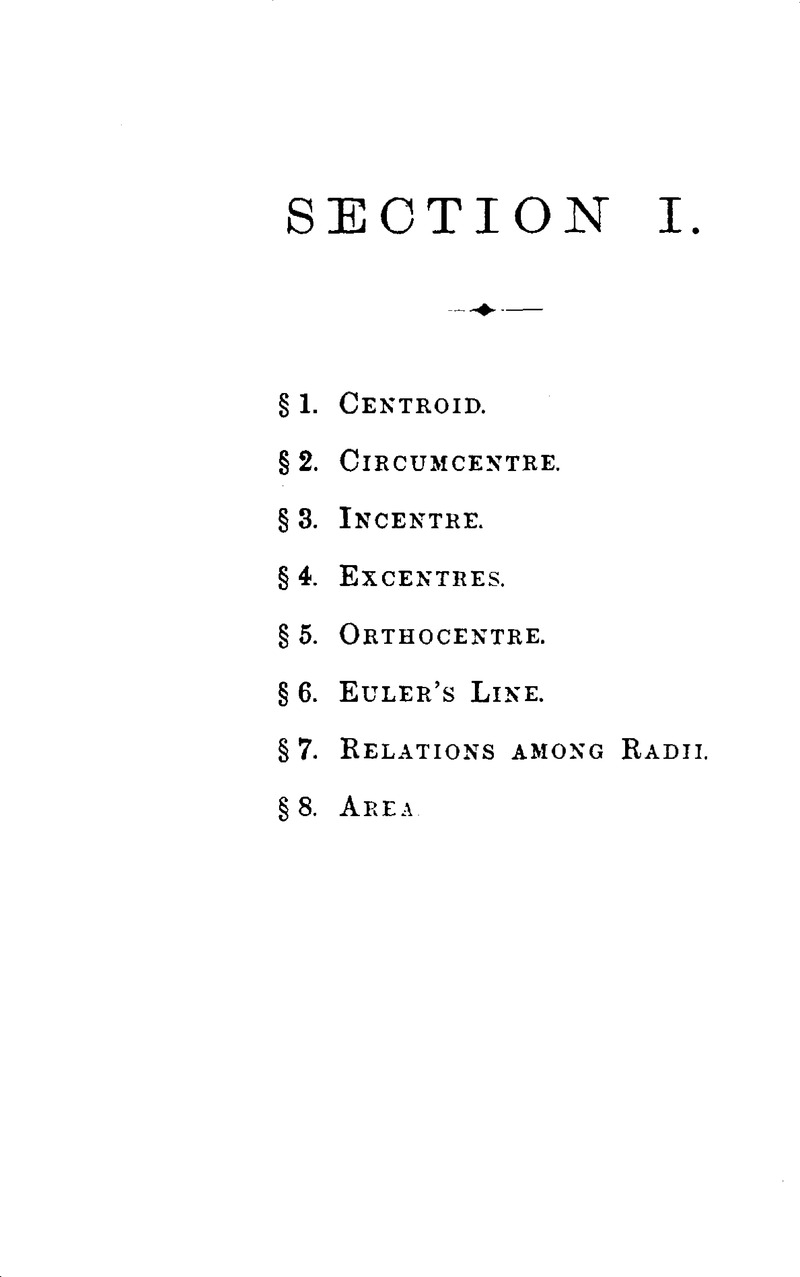No CrossRef data available.
Article contents
§1. Centroid
Published online by Cambridge University Press: 20 January 2009
Abstract

- Type
- Other
- Information
- Copyright
- Copyright © Edinburgh Mathematical Society 1883
References
* Archimedes, , De planorum cequilibriis, I. 13, 14.Google Scholar
† Archimedes.
‡ Carnot, , Géométrie de Position, p. 315 (1803),Google Scholar and Lhuilier, , Élémens d' Analyse, p. X. (1809).Google Scholar
§ This expression was suggested by Davies, T. S. in 1843 in the Mathematician I. 58. It had been used by Dr Hey in 1814 to designate another point.Google Scholar
∥ MrLemoine, E. in the Report (second part) of the 21st session of the Association Française pour l' avancement des sciences, p. 77 (1892).Google Scholar
* See MrVigarié's, Emile articles Sur les Points Complémentaires in Mathesis, VII., 5–12, 57–62, 84–9, 105–110 (1887).Google Scholar
* Jacobi, , De Triangulorum rectilineorum proprietatibus, pp. 5–6 (1825).Google Scholar
† Professor R. E. Allardice.
‡ MrGriffiths, J., in Mathematical Questions from the Educational Timet, V. 92 (1866).Google Scholar
§ Notes on the Geometry of the Plane Triangle, p. 65 (1867).Google Scholar
∥ Mathematical Questions from the Educational Times, V. 92 (1866).Google Scholar
* Lhuilier, , Élémens d' Analyse, pp. 1–2 (1809).Google Scholar
† The figure and demonstration refer only to this case. The other case and the consideration of what happens when BC is divided externally are left to the reader.
* This is a particular case of a more general theorem proved in Simson's, RobertApollonii Pergaei Locorun Planorum Libri II., pp. 179–180 (1749).Google Scholar
† Jacobi, C. F. A., De Triangulorum Rectilineorum Proprietatibus, p. 7 (1825).Google Scholar
* de Tuschis, J. F. a Fagnano in Nova Acta Eruditorum, anni 1775, p. 290.Google Scholar The article referred to is entitled: Problemata quaedam ad methodum maximorum et minimorum spectantia, and the volume in which it occurs was published at Leipzig in 1779.Google Scholar
† Watson, H. in the Ladies' Diary for 1756.Google Scholar
‡ Frépier in Gergonne's, Annales, VII. 170 (1816–7).Google Scholar
* Mrd'Ocagne, Maurice in the Nouvelles Annales, 3rd Series, I. 239 (1882); proof on p. 430.Google Scholar
† Leybourn's, Mathematical Repository, newBeries, V. 111 (1820).Google Scholar
* MrConolly, E. in Mathematical Questions from the Educational Times, IV. 76 (1865).Google Scholar
† MrWatson, Stephen, in Mathematical Questions from the Educational Times, XX. 109–112 (1873), where four solutions are given. The solution in the text is Mr Watson's.Google Scholar
* The theorem that A1B1C1 hat the same centroid as ABC will be found in Pappus's, Mathematical Collection, VIII. 2.Google Scholar Chasles has some remarks on the theorem in his Aperçu historique, 2nd ed., p. 44.Google Scholar
† This mode of proof was communicated to me by Mr A. J. Pressland. Compare also Fuhrmann's, Synthetische Beweise planimetrischer Säze, pp. 48–9 (1890).Google Scholar
* In connection with this subject, the following authorities may be consulted: Gergonne's, Annales, II. 93 (1811).Google ScholarSupplemente zu G. S. Klügel's Wörterbuche der reinen Mathematik, VoL I.Google Scholar Art. “Dreieck” (Grunert, J. A.), p. 706 (1833).Google ScholarNouvelles Annales, III. 457–460 (1844).Google ScholarBattaglini's, Giornale di Matematiche, I. 126–7 (1863).Google ScholarGrunert's, Archiv, XLI. 112–4 (1864).Google Scholar
* Gergonne's, Annales, II. 93 (1811).Google Scholar
† The figure has been taken from Grunert's article “Dreieck” previously referred to.
‡ Grunert's, Archiv, XLI. 112–4 (1864).Google Scholar
* Gergonne's, Annales, II. 93 (1811).Google Scholar
† Rev. Simmons, T. C. in Milne's Companion to the Weekly Problem Papers, pp. 150–1 (1888).Google Scholar
* Rev. Simmons, T. C. in Milne's Companion to the Weekly Problem Papers, p. 151 (1888).Google Scholar
† This property, proved in the manner given, will be found in Maclaurin's Algebra (1748) in the Appendix, De Linearum Geometricarum Proprietatibus generalibus Tractatus, §98 or p. 57.Google Scholar A proof by DrHunyady, E. V. of Pesth, by meant of transversals, will be found in Schlöimilch's Zeitschrift, VII. 268–9 (1862).Google Scholar




